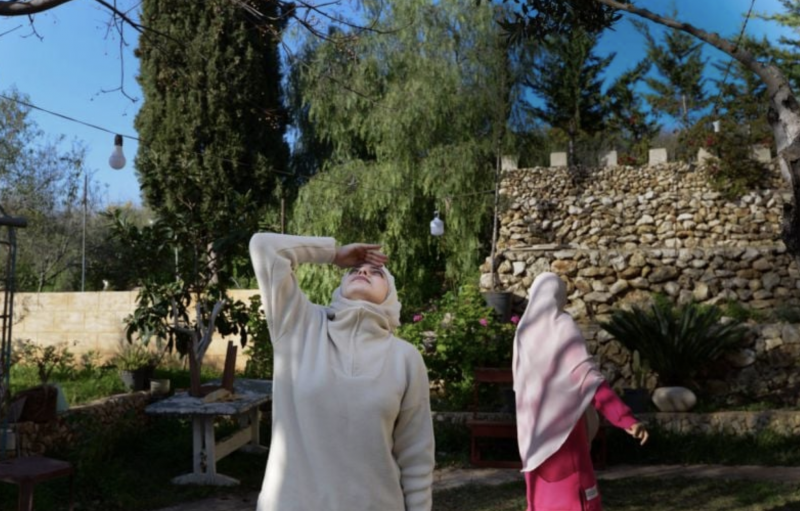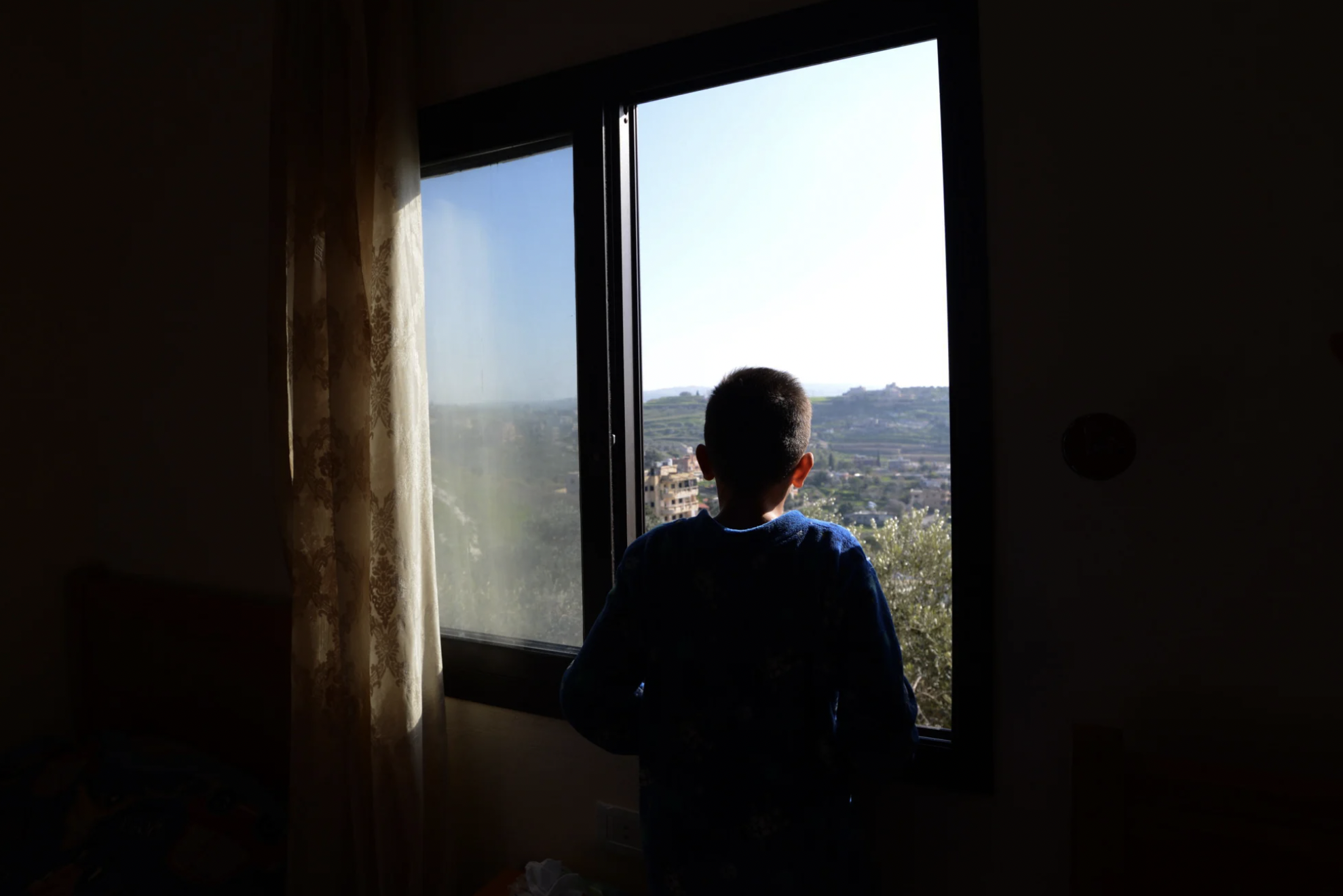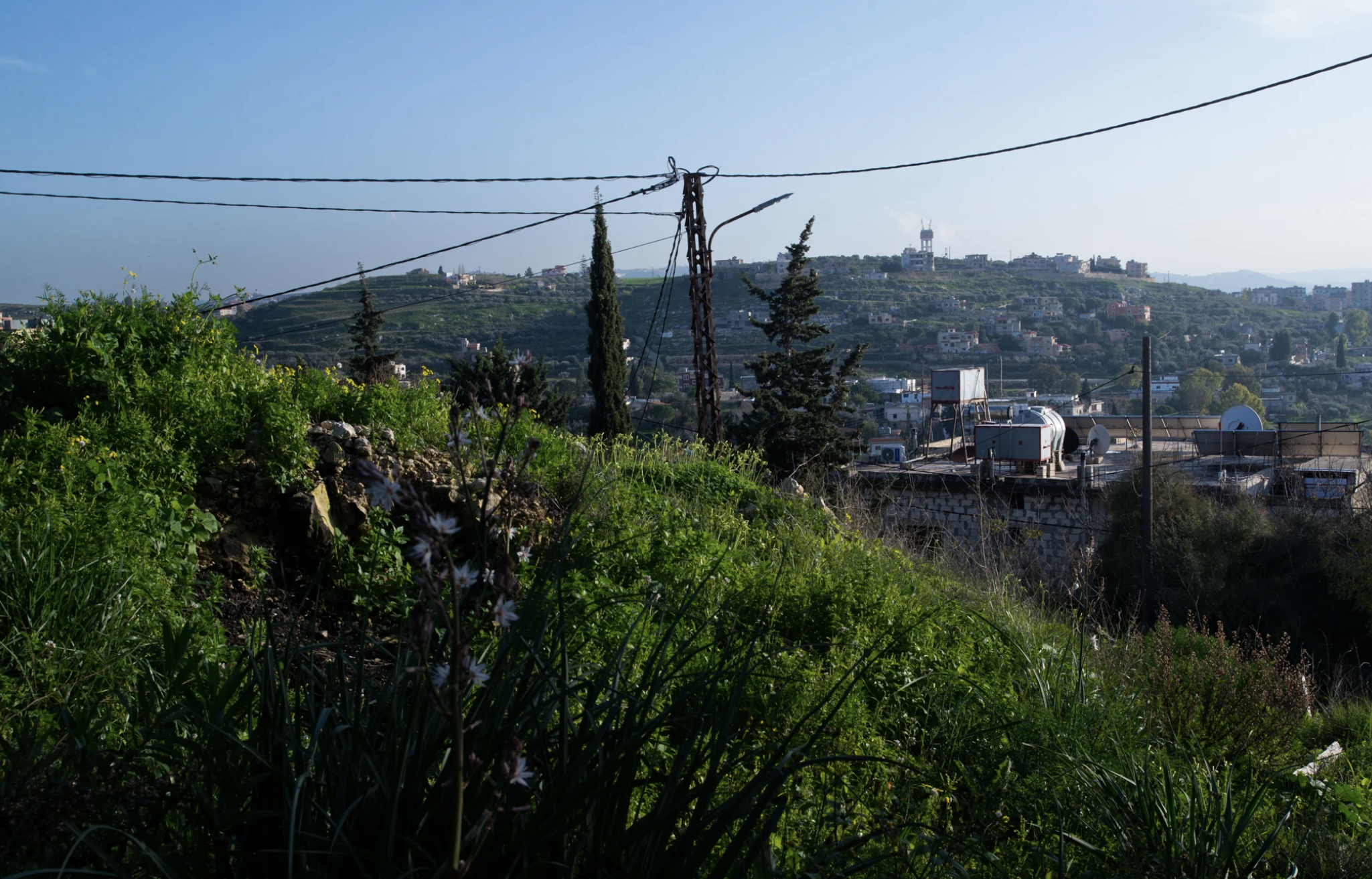
Nagham Kriek searching for an Israeli drone, Saturday Jan. 20, 2024, in the village of Arzoun, south Lebanon. (Credit: Lina Malers)
Nagham Kriek looks up to the sky but she can’t spot anything.
“Do you see that white dot there? That’s an MK. It’s spinning,” said her older sister Rahab, pointing toward the blue sky. Their mother, Azad, also looked up, intrigued, but couldn’t spot anything either.
“You can hear it though, it must be flying pretty low,” Kriek said, seemingly accustomed to the sound.
In the green surroundings of their family home in Arzoun, a predominantly Shiite village on the south bank of the Litani River, the conversation has once again shifted to the constant hum of the Israeli surveillance drone that the two sisters were trying to detect and photograph.
“Day and night, it never stops,” Kriekh said. “I haven’t slept in four days,” she added, referring to these overhead flights, which have recently become more frequent.
Sipping his sweet tea, Kriek’s father Amin, 59, said he had the impression that the buzzing is increasing, a sign that there may be two drones.
“Maybe Abu Kamel doesn’t want to leave Um Kamel alone,” he quipped — the townspeople in southern Lebanon amusingly refer to the MK drone as “Um Kamel.”
Amin Kriek sported a cheerful demeanor and easily cracked jokes, using his witty banter to lighten the mood for his family and friends. They have been grappling with the dire consequences of the recent wave of violence between Israel and Hezbollah, which began on Oct. 8 following Hamas’s attack the day before.
The Israeli airstrikes, resulting in almost 200 casualties, including 165 Hezbollah fighters, have predominantly focused on border villages. However, they persist in spreading further into southern Lebanon, carrying the imminent threat of an escalation.
“We will restore the security of the population in northern Israel through an international political arrangement designed to push Hezbollah back beyond the Litani River, based on UN Resolution 1701 [unanimously adopted by the UN Security Council in the summer of 2006 to conclude the 33-day war between Israel and Hezbollah],” said Israeli Defense Minister Yoav Gallant on Dec. 7, stressing that “if this arrangement fails, we will use force.”
Gallant then issued an ultimatum of six to eight weeks. Since then, French and American diplomats have intensified negotiations in Lebanon to pressure Hezbollah to agree.
As the deadline approaches, Israeli media reports suggested a proposal from Israel for a 48-hour truce. In the event of failure, Israel would prepare to intensify its military operations in southern Lebanon.
Today, the Litani River symbolizes the tipping point between the hope of a diplomatic solution and the risk of a regional escalation.
‘We like to welcome people’
In the meantime, the string of villages along the river has transformed into a rear base where displaced civilians sought refuge over the last few months.
Approximately 81 percent of the 82,000 displaced people are currently staying with host families across the country.
In the house that Amin Kriek built throughout his life, two families whose homes were bombed in Aita al-Shaab have been living there for two months.
“In the south, we like to welcome people,” said Kriek, adding that, like other residents of Arzoun who have opened their doors, he has not asked for anything in return.
But everything doesn’t boil down to the sense of hospitality.
Azad Kreik admitted that the plight of the displaced people in the south is a reminder of a tragedy they themselves suffered: “We were also forcibly displaced during the war in July 2006, so we know what it’s like to have no hot water or electricity... If we don’t take them in, who will?”
“They’re so comfortable here that we’re worried they’ll want to move in,” her husband quipped.
 One of the displaced children hosted by the Kriek family looks towards the border where his destroyed home is located, Jan. 20, 2024. (Credit: Lina Malers)
One of the displaced children hosted by the Kriek family looks towards the border where his destroyed home is located, Jan. 20, 2024. (Credit: Lina Malers)
On his phone, he showed a video from the previous evening: The two families from Aita al-Shaab are seated in a circle in his living room filled with antiques, while he recites zajal [popular Arabic poetry].
“I wanted to lighten their hearts of all the difficulties they are going through with poetry,” Amin Kreik said.
‘Less than 15 minutes’
“There's been a drone attack on a car in Barouzieh,” Rahab Kreik interrupted.
It was 1 p.m. Amin’s face darkened. He put his glasses back on, put his phone aside and turned on the television to check the news.
“Are there any martyrs? This time, they’ve really broken the rules of engagement,” he said. “Bazourieh is less than a 15-minute drive from here.”
After limiting itself to bombing the border zone, Israel has, for several weeks, been increasing the number of targeted assassinations of members of Hamas and Hezbollah in more in-depth strikes.
Rahab watched her daughter Rokaya, aged six, blowing up a balloon: “Her school is in Bazourieh,” she said in a hushed tone.
Suddenly, the war hit close to home. No longer a distant rumble or columns of smoke observed through binoculars, it was an Israeli drone firing missiles at a car just a 15-minutes drive away, on the way to school.
Is there a growing fear among the inhabitants of the Litani that the war will eventually reach them if Hezbollah does not withdraw its forces beyond the river?
“Since the start of the war, we’ve been concerned that it might spread here, but life has to go on,” says Rahab. “While schools may have closed at the border, they’re still open here.”
On the road along the Litani River, the shops lining were open, and life seemed to be going on as usual.
However, the faces of fallen soldiers plastered along the road to Arzoun betrayed the entrance to an area where the pulse of war was felt.
“In 2006, many of the area’s residents fled, but that won’t be the case this time,” said Amin, convinced that the development of Hezbollah’s military capabilities is now sufficient to dissuade Israel.
The party’s withdrawal beyond the Litani seemed to him to be “a fanciful demand” because “the resistance is made up of inhabitants of villages in the south who are defending their land,” he said.
“As soon as the war is over, they will take off their uniforms, put down their weapons and get back on their spades and ploughs,” he added.
Regarding Resolution 1701, Amin believed that Israel “should start by respecting its own commitments by withdrawing from Shebaa Farms and the Kfar Shuba Hills, among other places.”
Resolution 1701 calls for the implementation of the “seven-point” plan formulated at the end of July 2006 by then Lebanese Prime Minister Fouad Siniora.
This plan envisions an Israeli withdrawal from the Shebaa farms in favor of a UN force for a transitional period, while a definitive solution is negotiated for this disputed area. It is considered to be Syrian by the international community but claimed by Lebanon.
The Litani River, an old border dispute
Like many southerners, Amin Kreik’s mix of anger and suspicion toward Israel predates the 2006 war.
“I can’t forget the image of that Israeli tank in 1982 running over a car of displaced people and continuing on its way, leaving the family behind in a pool of blood,” he recalled of the Israeli invasion, four years after an initial incursion called “Operation Litani.”
In Arzoun, the occupying forces stayed for about a year, until 1983, he explained, during which time “it was impossible to work or cultivate your land without risking being targeted by Israeli soldiers.”
Israel’s complete withdrawal from southern Lebanon occurred on May 24, 2000.
Convinced that “Israel would have stayed here without the resistance operations against the occupation,” Amin said that “their objective is [to create] Greater Israel, from the Euphrates to the Nile.”
Will this happen via the Litani?
“As early as 1920, the Zionists formulated plans to exploit the water resources of the Galilee and lobbied hard to place the northern border of the Galilee along the Litani River,” said diplomats Frederic C. Hof and Philip C. Habib in their book Galilée divisée, la frontière israélo-libanaise, 1916-1984 (Divided Galilee, the Israeli Lebanese front, 1916-1984), published in 1985.
According to them, the control of the river was a response to a quest for a secure border and for water resources, allowing the cultivation of Palestine’s arid land.
This hope was dashed by the French and British proxy powers, who in 1923 set the border 40 kilometers lower, as part of the Paulet-Newcombe agreements.
The two diplomats recounted that 50 years later, in 1978, “a member of the Knesset reproached Israel’s Minister of Defense for not having simply seized the Litani River during the invasion of southern Lebanon.”
But according to several historians, the dream of annexing southern Lebanon is no longer on the agenda, as Israel’s objectives in Lebanon are security related.
There’s a family behind every fighter
It was 3:30 p.m., and the news was starting to pour in on the social networks among Arzoun’s townspeople.
“Apparently, there are four dead, two Palestinians and two Lebanese,” said Rahab Kriek. They were killed in the Israeli strike on Bazourieh, the home village of Hezbollah leader Hassan Nasrallah. She wondered whether one of them, Ali Mohammad Hodroj, was a former teacher of hers.
She later learned that he was a Hezbollah official, whose family she knows.
“We mustn’t forget that behind every fighter, there are grieving parents, children and friends,” she added.
 View of the village of Arzoun, near the Litani River in southern Lebanon, Saturday Jan. 20, 2024. (Credit: Lina Malers)
View of the village of Arzoun, near the Litani River in southern Lebanon, Saturday Jan. 20, 2024. (Credit: Lina Malers)
“Bazourieh is just next to Arzoun, on the other side of the hill,” said Hadi, Amin Kriek’s nephew.
“They’ve targeted fighters. That’s within the rules of engagement. Civilians are not yet under threat here,” said Hadi.
Since Oct. 8, at least 20 civilians have been killed in Israeli strikes in southern Lebanon, but so far in border villages.
This article was originally published in L'Orient-Le Jour. Translated by Sahar Ghoussoub. Edited by Yara Malka.